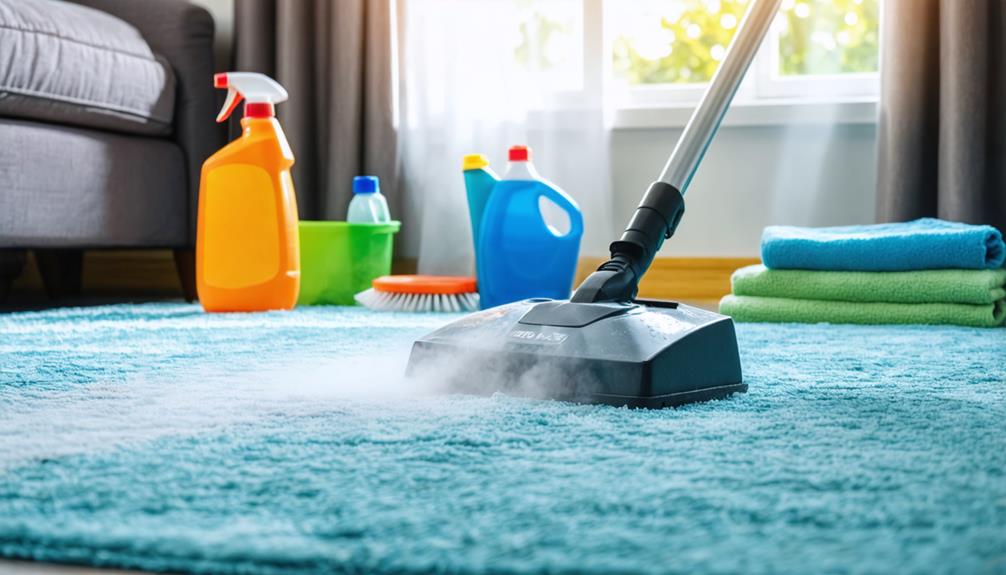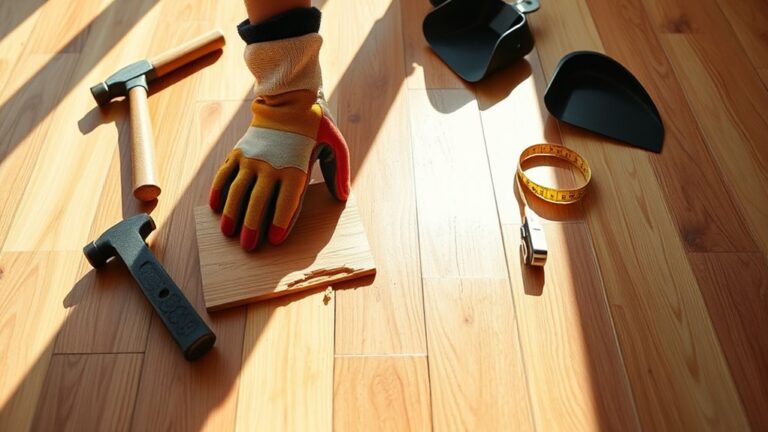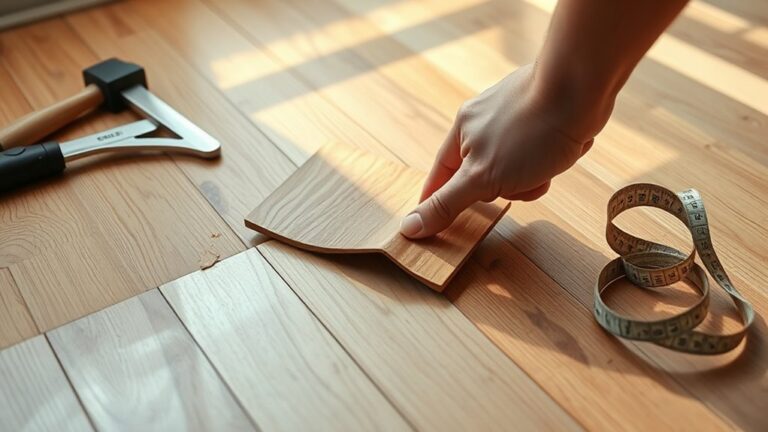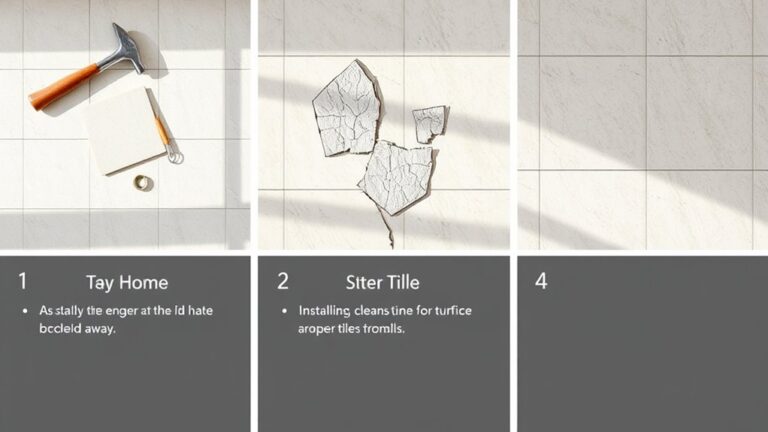To deep-clean your carpet floors effectively, start by vacuuming thoroughly to remove dirt and debris. Address spills immediately using the blotting technique to prevent stains. Use a vinegar solution (one part vinegar to three parts water) to lift deeper grime; dampen the carpet, let it soak, then blot to dry. For odors, sprinkle a mixture of baking soda and salt, scrub lightly, and vacuum after about fifteen minutes. Steam cleaning can help in removing embedded dirt. Make sure to maintain proper airflow while cleaning to enhance drying and prevent mold. There's plenty more to explore on keeping your carpets in prime condition.
How Often to Clean Carpet
When it comes to maintaining the cleanliness of your carpet, establishing a consistent cleaning routine is crucial. Start with regular vacuuming; depending on your household, you should aim to vacuum at least once a week. If you have pets or children, consider increasing this to twice a week. This helps remove dirt and debris before they settle into the fibers, keeping your carpet looking fresh and clean.
In addition to regular vacuuming, it's essential to address any spills or stains immediately. Use appropriate cleaning solutions tailored to the specific stain type to prevent them from becoming permanent fixtures on your carpet. The quicker you act, the better your chances are of maintaining a clean carpet.
Deep cleaning is equally important. Aim to deep clean your carpets at least twice a year. You can choose to hire professional carpet cleaning services or opt for DIY methods that suit your comfort level. Deep cleaning effectively removes embedded dirt and allergens, contributing to a healthier home environment.
When vacuuming, remember to move furniture regularly and adjust your vacuum height according to your carpet type for ideal cleaning results. For pet owners, employing a rubber-edged squeegee can work wonders in collecting pet hair, ensuring your carpet remains clean and free from allergens. By following these guidelines, you'll not only maintain a clean carpet but also enjoy a more inviting living space.
Effective Spot-Cleaning Techniques
When it comes to effective spot-cleaning, your immediate response to spills is vital. Start by blotting liquid spills with a paper towel or cloth to absorb moisture before it sets in, and for solid stains, gently lift them with a credit card or dull knife. Remember, using the right techniques can make all the difference in preserving your carpet's appearance.
Immediate Spill Response
Responding promptly to spills is vital for maintaining the integrity of your carpet. Start with immediate spill response by grabbing a clean white cloth or paper towels. Gently blot liquid spills from the outer edges toward the center to prevent spreading. The goal here is to absorb as much liquid as possible without pushing it deeper into the fibers.
For solid stains like mud or food, don't rub; instead, use a credit card or dull knife to carefully lift the residue. This technique helps maintain the carpet's texture and prevents further damage. After you've tackled the initial cleanup, it's time to apply a carpet stain remover. Follow the product instructions closely for ideal results.
Before using any cleaning solution, always perform a spot test on an inconspicuous area of your carpet. This guarantees you won't inadvertently cause discoloration. Remember, avoiding rubbing stains is essential; it can push them deeper into the carpet fibers, making removal much more challenging. By following these steps, you'll be well on your way to keeping your carpet looking fresh and clean.
Stain Removal Strategies
Effectively tackling stains on your carpet requires a strategic approach tailored to the specific type of stain. Start by addressing liquid spills immediately. Use a clean, white cloth or paper towel to blot the area, applying pressure from the outside in to avoid spreading the stain further. For solid stains like mud or food, gently lift the material with a credit card or dull knife without rubbing it into the carpet fibers.
Always refer to a stain removal chart for guidance. Different stains necessitate different cleaning solutions for effective removal. After the initial clean-up, it's essential to apply a carpet stain remover promptly. Before doing so, test the cleaning solution on an inconspicuous area to confirm it won't cause discoloration.
Proper Blotting Techniques
Blotting is an essential technique for managing spills and stains on your carpet. To begin, act fast! Use a clean white cloth or paper towel to gently blot the area, pressing down to absorb the liquid without rubbing. Rubbing can spread the stain, making it worse. For solid stains like mud or food, carefully lift the edges with a credit card or dull knife, working from the outside toward the center.
After the initial clean-up, apply a carpet stain remover according to the manufacturer's instructions. Always test it on an inconspicuous area first to avoid discoloration. Utilize proper blotting techniques by dabbing the stain instead of scrubbing; this protects your carpet fibers and prevents the stain from going deeper.
Once you've treated the stain, rinse the area with clean water. Blot again with a dry towel to absorb excess moisture. This not only promotes faster drying but also helps prevent mold growth. By following these effective spot-cleaning techniques, you can maintain your carpet's beauty and extend its lifespan.
Cleaning With Vinegar Solutions
To clean your carpets effectively with vinegar, you'll want to start by preparing a solution of one part distilled white vinegar to three parts cold water in a spray bottle. When applying this solution, dampen a small section of the carpet and let it soak for five minutes to loosen dirt and stains. Enhancing airflow during the drying process is vital, so consider opening windows or using fans to facilitate quicker drying and reduce the risk of mold.
Vinegar Solution Preparation
Creating a vinegar cleaning solution is a straightforward process that can yield impressive results for your carpet. To prepare your solution, mix one part distilled white vinegar with three parts cold water in a spray bottle. This cleaning solution is effective for both stain removal and deodorizing.
Before applying the solution, it's essential to test it on an inconspicuous area of the carpet to check for any adverse reactions or discoloration. Once you've verified it's safe, dampen a small section of the carpet (about 3ft x 3ft) with the vinegar mixture and allow it to soak for five minutes. This helps break down soil, making it easier to clean.
After soaking, use a clean microfiber cloth for blotting the area gently. Remember to rinse thoroughly with clean water afterward to prevent any residue build-up that could attract dirt. For enhanced cleaning power, consider combining the vinegar solution with baking soda to create a foaming action that lifts tough stains from carpet fibers.
| Step | Description |
|---|---|
| 1. Mix Ingredients | 1 part vinegar, 3 parts water |
| 2. Test Area | Apply in an inconspicuous spot |
| 3. Soak | Allow to sit for 5 minutes |
| 4. Blot and Rinse | Blot with cloth, then rinse thoroughly |
Application Techniques
When tackling carpet cleaning with vinegar solutions, it's important to employ effective application techniques to achieve the best results. Start by mixing one part distilled white vinegar with three parts cold water to create a powerful cleaning solution. Here's how you can apply it:
- Dampen the Area: Apply the vinegar solution onto a small section of carpet, roughly 3ft x 3ft. Allow it to sit for five minutes. This waiting period helps the solution penetrate and loosen dirt and odors.
- Blot the Area: After letting the solution sit, take a microfiber cloth and blot the treated area. Rinse the cloth frequently in clean water to lift dirt effectively and prevent any residue buildup.
- Repeat if Necessary: If the area still appears dirty, reapply the solution and repeat the blotting process until the carpet is thoroughly clean.
Always remember to test your vinegar solution on an inconspicuous patch of carpet before applying it everywhere. This precaution guarantees you avoid any unwanted discoloration or damage. With these techniques, you'll keep your carpets looking fresh and clean!
Drying and Airflow
Effective drying and airflow are essential after cleaning carpets with vinegar solutions to guarantee ideal results. Once you've cleaned the carpet, avoid over-saturating it to prevent damage from excessive moisture. Dampen a small area, allowing the vinegar solution to soak for five minutes before blotting. Afterward, rinse with clean water to remove residues that could attract dirt and odors.
To promote faster drying, increase airflow in the room. Open windows and use fans to enhance air circulation. This not only helps the carpet to fully dry but also prevents mold growth by reducing humidity levels. Monitoring humidity is vital; ideally, you want it to stay between 30% and 50%. If your area has high humidity, consider using a dehumidifier to improve drying effectiveness.
Using Baking Soda and Salt
Using baking soda and salt can be a game-changer for deep cleaning your carpet floors. This powerful duo serves as an effective cleaning agent that not only absorbs odors but also helps to remove dirt embedded in your carpet fibers. Here's how to make the most of these ingredients:
- Prepare Your Carpet: Start by thoroughly vacuuming the carpet to remove any loose debris. This step guarantees that the baking soda and salt mixture can penetrate the fibers more effectively.
- Create Your Mixture: In a bowl, mix equal parts of baking soda and salt. This combination will act as a potent cleaner and deodorizer.
- Application and Activation: Sprinkle the mixture liberally over the carpet in a grid pattern. Let it sit for at least 15 minutes to maximize its cleaning potential. After that, lightly dampen the area with plain water from a spray bottle. This activates the cleaning properties of the baking soda and salt.
Next, use a scrub brush to work the mixture into the carpet fibers, helping to loosen soil and grime. Once you've scrubbed the area, wipe away the loosened soil with towels. Finish by vacuuming the area again to remove any remaining residue, leaving you with fresh, revitalized carpet. With these simple steps, you can enjoy the freedom of a clean home without relying on harsh chemicals.
Steam-Cleaning Your Carpet
Although steam-cleaning your carpet may seem intimidating, it's an incredibly effective method for deep cleaning that can breathe new life into your floors. To achieve the best results, you need to follow a systematic approach.
Start with thorough vacuuming to remove loose dirt and debris, which allows for more effective deep cleaning. Next, prepare your carpet by sprinkling a mixture of baking soda and salt on the surface, helping to loosen dirt and odors. This step enhances the effectiveness of your steam cleaner.
When you're ready to steam-clean, hold the steam cleaner head 6-12 inches above the carpet. This prevents over-saturation, which can damage the carpet backing. Work the steam cleaner slowly over the carpet, alternating between pressing and releasing the trigger to let the steam penetrate the fibers and break down dirt and grime efficiently.
Once you've finished steam-cleaning, it's vital to allow the carpet to dry completely. Increase airflow by using fans or opening windows to prevent mold growth and musty odors. Here's a quick reference table to guide you through the process:
| Step | Action | Purpose |
|---|---|---|
| 1. Vacuum | Remove loose dirt and debris | Enhances cleaning effectiveness |
| 2. Prepare | Sprinkle baking soda and salt | Loosens dirt and odors |
| 3. Steam-Clean | Hold cleaner 6-12 inches above carpet | Prevents damage |
| 4. Drying | Increase airflow | Prevents mold growth |
General Carpet Cleaning Practices
After ensuring your carpets are deeply cleaned through steam cleaning, maintaining their appearance and hygiene with regular care becomes important. Consistent cleaning is essential to extend the life of your carpet and keep it looking fresh. Here are some key practices to follow:
- Vacuum Regularly: Vacuuming at least once a week is vital, especially in high-traffic areas or homes with pets and children. This helps remove loose dirt and prevent dirt buildup, which can lead to premature wear. Adjust your vacuum height settings according to your carpet type for best results.
- Spot Cleaning: When spills occur, address them immediately. Blot the area gently with a paper towel or cloth—don't rub, as this can spread the stain further. Use a suitable cleaning solution based on your carpet fiber type to effectively treat the stain.
- Deep Clean: It's important to deep clean your carpet at least twice a year. Depending on your carpet type, methods like steam cleaning or dry cleaning are effective to maintain both appearance and hygiene. Moving furniture regularly allows for thorough vacuuming and helps prevent dirt accumulation in hidden areas.
Understanding Carpet Types
Understanding the different types of carpet fibers is essential for effective cleaning and maintenance. Each carpet type has unique characteristics that dictate its cleaning needs and sensitivities. For instance, wool carpets require gentle cleaning methods due to their sensitivity to heat and moisture. Using aggressive cleaning agents can damage these luxurious fibers, so it's important to opt for milder solutions that safeguard their integrity.
Nylon carpets, on the other hand, are known for their resilience. They can withstand aggressive cleaning techniques, such as steam cleaning, making them suitable for high-traffic areas where wear and tear are common. Their durability allows you to maintain their appearance with less concern about damage.
Polyester carpets are celebrated for their stain-resistant properties, but they do require careful attention. If not dried properly, they can flatten, losing their plush look. To maintain their appeal, it's essential to employ cleaning methods that focus on thorough drying while still addressing stains effectively.
If you're unsure about your carpet type, a burn test can help. Different fibers emit distinct odors and ash characteristics when burned, allowing you to identify the material. Understanding these carpet types will empower you to choose the right cleaning methods, ensuring your carpets remain beautiful and functional for years to come.
Step-by-Step Deep Cleaning Process
Now that you're familiar with the various carpet types and their specific cleaning needs, it's time to get into the step-by-step deep cleaning process. This methodical approach will help you achieve ideal results, enhancing both the appearance and longevity of your carpet.
- Vacuum Thoroughly: Begin by vacuuming the entire carpet, focusing particularly on high-traffic areas and corners. This step is crucial to remove any loose dirt and debris that can interfere with the deep cleaning.
- Pretreat Stains: Next, identify any visible stains and apply a stain-removing spray. Allow it to sit for a few minutes; this loosens the stains and prepares them for removal during the main cleaning process.
- Set Up and Clean: Fill your carpet cleaner's clean tank with hot tap water mixed with the recommended cleaning solution. Confirm the solution is compatible with your carpet type to avoid damage. Start cleaning from the farthest corner of the room and work your way backward. As you clean your carpet, alternate between pressing the trigger for solution release and letting the brush rolls scrub the fibers.
Optionally, you can finish with a rinse using hot tap water to eliminate any leftover cleaning solution. This final touch enhances your carpet's overall cleanliness, making sure it looks fresh and feels inviting. Following these steps will give you the freedom of a beautifully maintained carpet.
Maintenance Tips for Longevity
Maintaining the longevity of your carpet is vital for preserving its beauty and function over time. By following some straightforward maintenance tips, you can guarantee your carpets remain fresh and resilient. Start with regular vacuuming; aim for at least once a week, but increase that to twice a week if you have pets or children. This practice removes dirt and debris that can wear down fibers.
Consider deep cleaning your carpets at least twice a year. Whether you opt for professional cleaning or DIY methods, this will extend the carpet's lifespan and improve your indoor air quality. Additionally, using mats in high-traffic areas and applying stain protectants are smart ways to protect your carpet from spills and stains.
Monitoring humidity levels is essential. High humidity can lead to mold and mildew growth, which damages carpets and affects air quality. Schedule professional cleaning every 6 to 12 months, especially in high-traffic areas, to maintain thorough care and avoid costly replacements.
Here's a simple table to summarize these tips:
| Maintenance Tip | Frequency |
|---|---|
| Vacuuming | At least once a week |
| Deep Cleaning | Every 6-12 months |
| Monitor Humidity Levels | Regularly |
Safety and Environmental Considerations
When cleaning your carpet, it's essential to choose non-toxic cleaning solutions to protect the health of your family and pets. Guarantee proper ventilation during the process by opening windows or using fans, as this helps maintain indoor air quality and reduces lingering odors. By prioritizing these safety measures, you can create a cleaner, healthier environment in your home.
Non-Toxic Cleaning Solutions
Choosing non-toxic cleaning solutions for your carpet floors not only protects your health but also contributes to a cleaner environment. By avoiding harsh chemicals commonly found in commercial products, you can enhance your indoor air quality and create a safer space for your family and pets. Here are three effective non-toxic options to reflect upon:
- Vinegar: This versatile cleaner can eliminate stains and odors while acting as a natural disinfectant.
- Baking Soda: Known for its odor-absorbing properties, baking soda can help refresh your carpets and tackle tough stains.
- Plant-Based Cleaners: Hypoallergenic and eco-friendly, these options minimize allergic reactions and promote a healthier home atmosphere.
When you choose eco-friendly cleaning solutions, you're not just reducing your exposure to harmful substances; you're also limiting your environmental impact by using biodegradable ingredients. Remember, proper ventilation during and after cleaning with these non-toxic solutions is essential. It helps to further improve air quality, ensuring that any lingering moisture doesn't lead to musty odors or mold growth. By opting for these non-toxic alternatives, you're making a conscious decision for both your health and the planet.
Ventilation During Cleaning
Ventilation plays an essential role during the carpet cleaning process, as it helps minimize moisture accumulation and reduces the risk of mold and mildew growth in your home. To achieve ideal ventilation, open windows and doors to create cross-ventilation. This allows fresh air to circulate, which helps harmful fumes from chemical cleaners dissipate quickly.
Consider using fans to enhance airflow, speeding up the drying process of your carpets and minimizing the risk of musty odors developing. It's vital to monitor indoor humidity levels; ideally, keep them below 60% to discourage mold growth and maintain a healthy environment during and after deep cleaning.
If you're using chemical cleaners, ventilation becomes even more important. Proper airflow can protect sensitive individuals from potential respiratory issues caused by lingering fumes. Remember, the goal is to create a space that feels fresh and inviting, free from the hidden dangers of trapped moisture and pollutants. By prioritizing ventilation, you not only safeguard your carpets but also promote a healthier living environment for everyone in your home.
Frequently Asked Questions
How to Deep Clean a Carpeted Floor?
To deep clean your carpeted floor, start with effective vacuuming techniques to eliminate dirt. Then, choose from various carpet cleaning methods—like steam cleaning, which offers benefits such as odor removal and effective stain treatment. Consider using eco-friendly products and natural cleaning solutions for a healthier home. After cleaning, follow carpet drying tips, like increasing airflow, to prevent mold. Regular carpet maintenance tips guarantee longevity and keep your space fresh and inviting.
What Is the Best Way to Clean Heavily Soiled Carpet?
To clean heavily soiled carpet, start with effective vacuum techniques to lift loose dirt. Next, tackle stain removal by pre-treating spots with a suitable solution. For deep cleaning, consider carpet shampooing or steam cleaning, using a pH-balanced product. Rinse thoroughly to prevent residue, ensuring odor elimination. Regular carpet maintenance is key, so explore DIY solutions or consider professional services for tough stains, helping your carpets look fresh and last longer.
How Do I Get the Best Results From Carpet Cleaning?
Did you know that 80% of dirt in carpets is dry, making effective vacuuming essential? For the best results, start with proper vacuuming methods to remove loose debris. Use appropriate cleaning solution types tailored to your carpet. Incorporate stain removal tips by treating spots beforehand. Explore eco-friendly options or consider professional services for deep cleaning. Regular carpet maintenance, including DIY remedies, can extend the life of your carpets and keep them looking fresh.
What Is the Best Way to Get Deep Stains Out of Carpet?
To tackle deep stains, you've got a few effective stain removal techniques at your disposal. Start with DIY carpet remedies like a vinegar-water solution for stubborn stains. If that doesn't work, consider professional cleaning services for tough issues. Remember, using eco-friendly options not only helps the planet but also protects your carpet fibers. Finally, incorporate carpet maintenance tips and protection methods to prevent future stains from setting in. You'll enjoy cleaner carpets!




